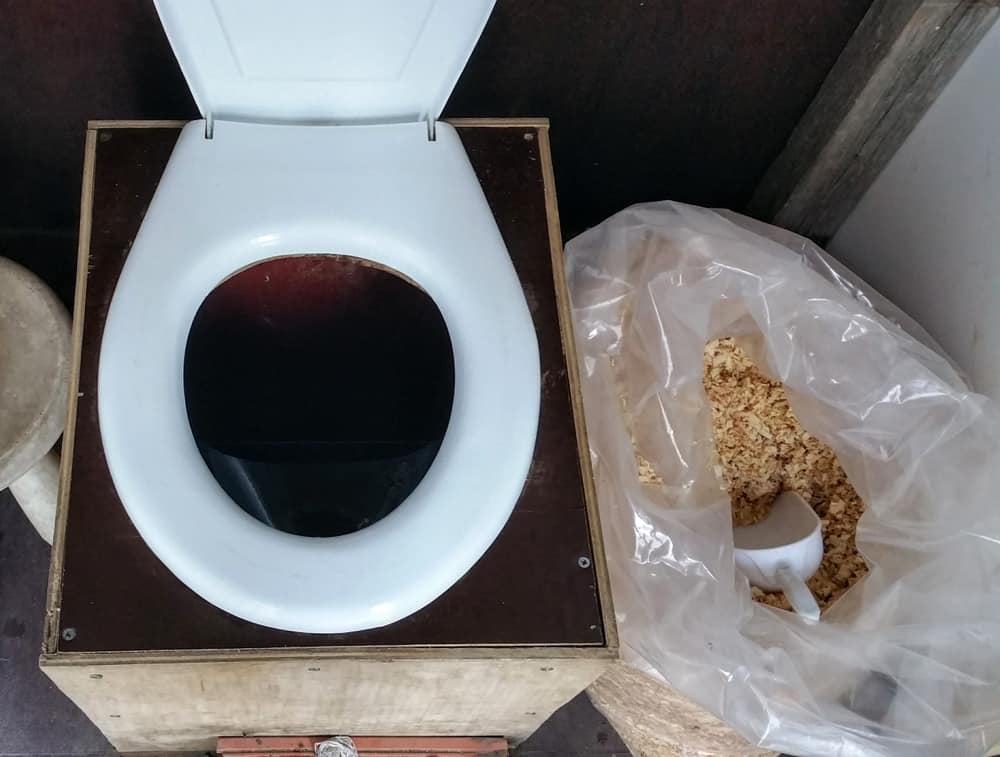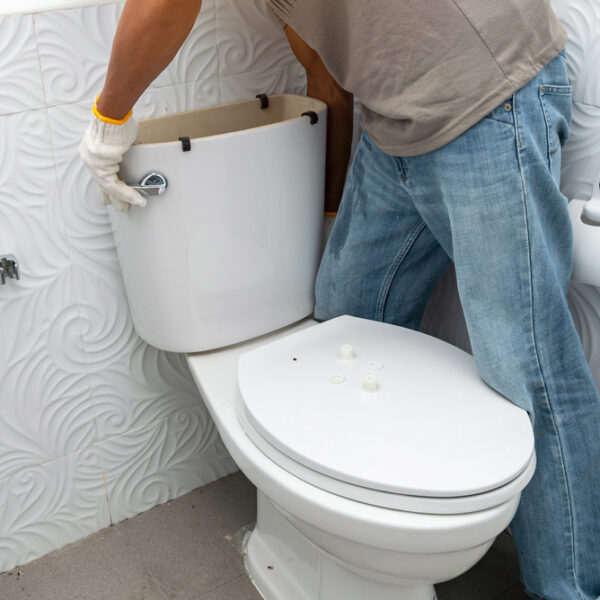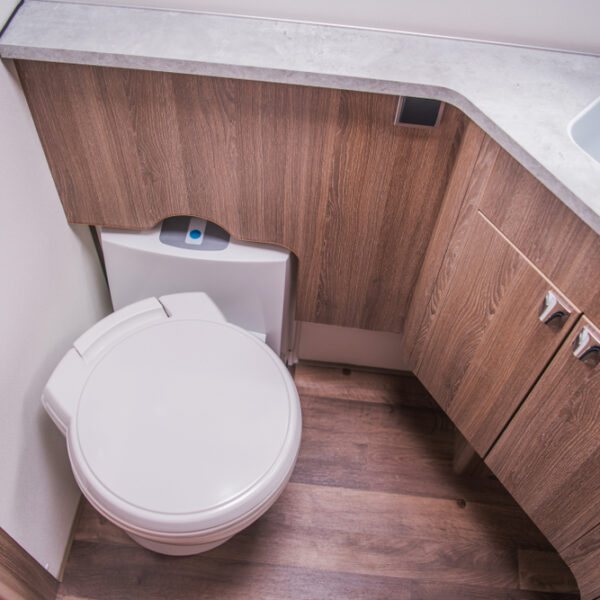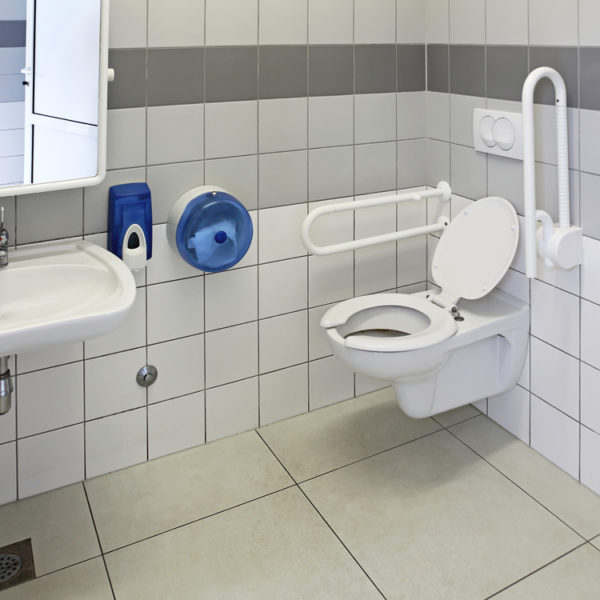If for some reason you don’t want to or are unable to install a regular flushing toilet in a particular location, composting toilets can be a great solution. They are convenient, easy to maintain, environmentally friendly and even produce compost you can spread on your garden.
One of the few running costs associated with these toilets is the bulking material you use to cover the waste and soak up excess moisture – and to help you understand the options, in this post, we discuss which are the best cover materials for composting toilets.
What should you look for in Composting Toilets cover materials?
Before we think about the best options for cover materials for composting toilets, we need to think a little bit about what we expect of these materials.
The best cover materials combine several important features, which include the following:
- Visual cover
- Hide odors
- Aid composting process
- Absorbent
- Ecological
The first two are quite obvious – if you are using a composting toilet, you will want something to physically cover the waste so you can’t see it, and you will also want something that hides the smell. If not, using the composting toilet will be a fairly unpleasant experience.
However, you also want a material that helps turn the waste into compost, and there are several factors that play a role.
The cover material should be organic since this will add carbon to the mix – microorganisms need this as their source of energy as they break the waste down into compost.
The material you use also needs to contain the microorganisms – beneficial bacteria – that are responsible for transforming the waste into usable compost, and the mix needs to be porous enough to allow oxygen to reach these microorganisms or they won’t survive.
At the same time, you need a bulking material that’s absorbent to a certain degree. Solid waste contains moisture that needs to be soaked up by the cover material, and liquid waste also needs to be soaked up if the toilet isn’t a urine-diverting model that separates it out.
Finally, the material you choose should be ecological. Many people switch to composting toilets because they represent a more environmentally friendly option than a flushing toilet – so it makes sense to choose the greenest option available.
Even if your primary reason for using a composting toilet isn’t environmental, it’s still preferable to try to protect the planet – although we also understand that to some people, this might not be such an important consideration.
Best Cover Materials for Composting Toilets options
So now we know what we’re looking for in our covering material, let’s evaluate some of the possible candidates.
1. Coconut coir
Coco coir is the husk that is removed from the coconut shell, and it is sold as solid bricks. Each brick is highly compact, but when you add water, the coir expands into a soil-like substance that is a popular medium among gardeners for germinating seeds.
A single brick of around 6” can give you about two gallons of useable coir, and as well as its common use as a planting medium, it’s also an excellent choice of covering material in composting toilets.
It does a great job of physically covering the waste, and it also hides the smell well. It is highly absorbent, but it is porous enough to allow for composting to take place – coir is a good material for helping to get the composting process underway.
Nowadays, thanks to the popularity of coconut products, it’s readily available online and in gardening outlets, and since it’s sold in compact bricks, it’s easy to store – you can buy in bulk to save money since it doesn’t take up much space.
Coir is a by-product of the coconut growing industry, and if it wasn’t used for gardening or in composting toilets, it would simply be thrown away or even burned. This, along with the fact that it’s renewable makes it an ecological choice.
However, it isn’t without issues. Since much of North America is located some distance from the world’s major coconut-producing countries and regions, there is a considerable carbon footprint associated with bringing this product to most of the US.
Another slight downside is that if you don’t want to prepare a whole brick’s worth of coir, it can be hard to break off a chunk – although this can be done with the aid of a saw.
That said, apart from these minor negatives, coir is still among the best options to use in a composting toilet.
Note that when using coir in a composting toilet, you should use less water to expand it than is recommended for gardening use – probably about a quarter of what is indicated on the packaging is about right.
Pros
- Good as a physical cover and at hiding smells
- Comes in small bricks so easy to store
- Easy to find online and in physical stores
- Renewable by-product
Cons
- Carbon footprint associated with transporting it from coconut-growing areas
- Hard to break up a brick to prepare smaller quantities
2. Chopped straw
Chopped straw or hay is often sold as bedding for animals and can be picked up inexpensively at any pet store. Sometimes you can buy it in bulk from farms, in which case, it will be even more economical.
It is the by-product of growing crops like wheat, barley or rye, and since it doesn’t have to travel far, it’s among the most ecological choices.
In terms of physically covering the waste, it does a great job, but it isn’t particularly absorbent, so it doesn’t do much for any unpleasant smells, and it won’t soak up the extra moisture if your compost mix is too wet.
With straw, you also need to make sure it is cut up into small enough pieces, otherwise it won’t work at all.
It can do a good job of composting, but it requires a little preparation – it’s best to leave it outside for a while to pick up some moisture from the rain. This will allow the necessary bacteria to colonize it, ready to start work composting your waste.
In short, chopped straw can be a good option thanks to its price, easy availability and green credentials, but it may need a bit of prep and doesn’t perform well in terms of odors.
However, it could be made to work better in combination with other materials such as woodchips.
Pros
- Easy to find
- Inexpensive
- Agricultural by-product so a sustainable option
- Good for covering solid waste
Cons
- Not the best in terms of smells
- Needs to be prepared before use
3. Sawdust or wood shavings
When we talk about sawdust or wood shavings, there are different kinds to consider.
The sawdust that is generated by something like a table saw is too fine and would be a poor choice for use in a composting toilet since it would turn to sludge. However, courser sawdust can work well.
It is organic and contains carbon, so it works well in composting, and it is also absorbent, so it can help soak up moisture as well as physically covering the waste in the tank. On the downside though, when used alone, it isn’t the best at concealing unpleasant smells.
Since sawdust is a by-product of woodworking, it can be free – and if not, it’s often sold as pet bedding, so it’s still inexpensive and easy to find.
Like with straw, it can be beneficial to activate the sawdust by leaving it outside in the rain for a while – you don’t want it to be sodden, but introducing a little moisture and allowing it to sit will allow good bacteria to colonize it before you add it to your toilet.
Note that you should never use sawdust (or woodchips – see below) from treated wood or plywood since it will likely contain plastics, glues and other polluting substances.
Pros
- Inexpensive
- Readily available
- Good at covering solid waste
- Absorbent
Cons
- Less good at masking smells
- Needs activation to be most effective
4. Wood chips
Wood chips are larger than sawdust and are used as mulch and sometimes to make outdoor paths – although the size of the chips needs to be right for composting toilets because if they are too large, they will take too long to break down.
Wood chips have many of the same advantages as sawdust in that they are easy to find, don’t cost much and are a good choice for covering solid waste. Furthermore, they are better at concealing the unpleasant odors of a composting toilet.
They are also an ecological option since they are a by-product of woodworking, and they contain carbon, making them good for composting.
On the downside, wood chips take longer to break down into compost, and like sawdust and straw, they work better if they are activated by being left outside before being used.
Pros
- Ecological option
- Better at controlling smells
- Don’t cost much
- Easy to obtain
Cons
- Take longer to compost
- Need to be activated
5. Hemp stalks
Using the stalks from hemp plants is a less common solution, but it’s one of the best. Hemp stalks are absorbent and effective at containing smells, and they break down quickly, speeding up the composting process.
They are also extremely sustainable since hemp is among the fastest-growing plants in the world – it grows at a rate comparable to bamboo. Hemp cultivation also requires little water and no pesticides, further enhancing its ecological reputation.
One minor downside is that, like straw, it needs to be chopped up to a suitable size before use in a composting toilet – so it may need some extra processing by you before you can use it.
However, the major issue is that it is not as easy to find as many other options – but if you can find it, either online or locally – it’s one of the best choices around.
Pros
- Sustainable
- Absorbent
- Good at hiding smells
- Composts easily
Cons
- Harder to find
- May need extra chopping before use
6. Compressed wood pellets
Compressed wood pellets are used as cat litter or as horse bedding – and sometimes as stove pellets. To use them in a composting toilet, you will need to add a little water, but otherwise, they are another top choice.
They cover solid waste well, absorb moisture, work as a good bulking agent and hide smells. They are also usually an ecological option and are easy to store and use.
The only arguments against them are that they can be harder to find and are more expensive than some of the other possibilities, but otherwise, they are as good as any other option available to use as a cover material.
Pros
- Masks smells
- Absorbent
- Environmentally friendly
- Easy to store and use
Cons
- Expensive
- May be harder to find
Some other options you might try
Other than the suggestions above – which are all recommended choices – there are some other options you might consider trying in a pinch. So let’s have a quick look at some of those next.
7. Grass cuttings
When you mow your lawn, there’s a good chance you throw your cuttings on your regular outdoor compost pile – so you might be wondering if you can use them in a composting toilet instead.
The answer is that you can – but they need to be dried first. Fresh cuttings contain too much moisture to be an effective cover material in a composting toilet, and in addition, the combination of fresh grass and urine produces a vile smell.
This means if you have a large supply of dried grass, go ahead and use it – but the time it takes to obtain and then dry enough grass cuttings to use will be too labor-intensive to make this a viable option for most.
8. Leaves
Leaves and tree clippings are also compost pile regulars, so are they a good cover material for composting toilets?
The answer is similar to the answer for grass clippings. They can be used, but they need to be dried first.
In the right form, they can be a decent option to turn to – they’re good for covering solid waste, they hide smells well, they compost easily and they’re free.
However, finding a ready supply of suitable leaf matter might not be easy – and furthermore, you’ll also need to spend time picking out any larger twigs and branches before you can use them.
9. Coffee
Used coffee grounds are commonly added to compost heaps, usually contributing to compost of a high quality. However, you shouldn’t use coffee grounds as your sole cover material because they won’t perform well.
That said, coffee grounds can be added to some of the other materials mentioned above to make a more effective mixture – not only will they add to the desirable properties of whatever else you are using but they will also help to mask unpleasant smells.
10. Pine needles
An interesting idea is to use pine needles as a covering medium, and in theory, they would work well.
However, it is not usually easy to find a source of dried pine needles in large enough quantities to use – and it’s not practical to go traipsing through the forest picking up handfuls here and there to use in your toilet.
This means if you are lucky enough to have a ready supply of dried pine needles, you can certainly use them in your composting toilet – but for most people, this is not likely.
And some to avoid
As well as the materials we recommend for use, there are also a few we recommend you avoid – and the first might come as something of a surprise.
1. Peat moss
Peat moss – otherwise known as sphagnum moss – is a material that is commonly used in composting toilets, and it has all of the properties you could want from a medium.
It is easy to spread over your solid waste, covering the things you don’t want everyone to see, it is highly absorbent and excellent at hiding unpleasant smells.
Furthermore, it is also among the best materials for composting, so the contents of your toilet will quickly transform into something you can use as fertilizer.
However, peat moss is harvested from peat bogs, which are considered valuable habitats for a variety of animals and also act as a carbon sink much like tropical rainforests.
However, unlike rainforests, peat bogs regenerate at an extremely slow rate – they grow at the speed of only about 1mm a year. This means that once they are harvested, they take centuries to grow back, making them completely unsustainable.
For this reason, although in all other ways, peat moss would seem to be the perfect material for use in a composting toilet, we can’t recommend it.
2. Wood ash
Some people have tried using wood ash in their composting toilets, and in theory, it could work. You simply remove the ash from your fireplace and use it to fill your composting toilet.
However, while it can do a good job of covering waste products and even hiding smells, it doesn’t compost well and can be extremely messy too – however, careful you are, you are still likely to cover your bathroom, toilet seat and everywhere else in a thin coat of dust.
Also, once it reaches your compost heap, it will combine with the other contents to create ammonia, evaporating off the nitrogen and reducing the potency of your fertilizer.
Another consideration is that if it gets too wet, ash will turn to a nasty swill, so that’s one more reason to avoid it.
Note that even if after what we’ve just said, you are still tempted to give it a go, you should never use coal ash since it contains toxic compounds.
3. Soil
Soil might seem like a promising possibility, but in reality, it’s another one to avoid.
While soil is natural, organic, filled with beneficial bacteria and free, it’s not a good idea to use it in a composting toilet since it won’t hide the smells and will turn into a dirty, slushy mess if it gets too wet.
Composting Toilets cover materials FAQ
To finish, here are a couple of frequently asked questions about cover materials used for composting toilets.
Can you use toilet paper?
Something many people wonder is if you can throw toilet paper into your composting toilet, and the answer is you usually can.
Toilet paper is largely organic and will break down into compost just like anything else. It will also help soak up any excess moisture, so it can actually be a good idea to put toilet paper into the toilet, especially if you are using a medium that doesn’t have great absorption properties.
However, bear in mind that throwing paper into the toilet will cause it to fill up more quickly, which will, in turn, mean you need to empty it more often.
On the other hand, you might feel it’s better to keep things simple rather than having a separate container for paper – especially if you have guests who are not used to using a composting toilet.
If you do decide to throw toilet paper into the toilet, it’s better to choose marine toilet paper or similar – although there is no problem using regular toilet paper instead.
However, you should never throw any other items like sanitary towels into a composting toilet.
Can you use semi-composted material?
Another idea that might occur to some people could be to use semi-composted material from their regular pile to cover their composting toilet. However, this is usually something to avoid.
If your compost pile includes food scraps from the kitchen, in a half-composted state, this will create a terrible smell and may also attract flies, bugs and the like.
However, if you have a compost pile that only consists of wood chips, leaves and other similar matter, this could be a possibility.
You could also potentially use completely composted material – but then why would you want to do that when it’s already mature and ready to be used as a potent fertilizer on your flowers and plants?
Do you have to use a cover material?
Not all composting toilets require you to use a cover material, especially urine-diverting models.
However, almost every composting toilet can benefit from at least having a layer of bulking medium at the bottom of the tank to help soak up any excess moisture, and most people will prefer to use something to cover the human waste that will otherwise be visible.
If you have a model that allows you to not use cover material, the choice is up to you – but you should check the user manual first to make sure you know whether your toilet requires cover material, whether such material specifically should not be used or whether it is optional.
Plenty of choices for what to use
In this post, we’ve covered some of the most commonly used materials as well as some of the other options that could potentially be used. However, there is no single material that is best in all situations since toilets and usage vary.
The best advice is to experiment with some of the options here that sound like they could work well for you – as well as possibly trying out some combinations. That way, you will be able to work out which is the best cover material for your composting toilet.











